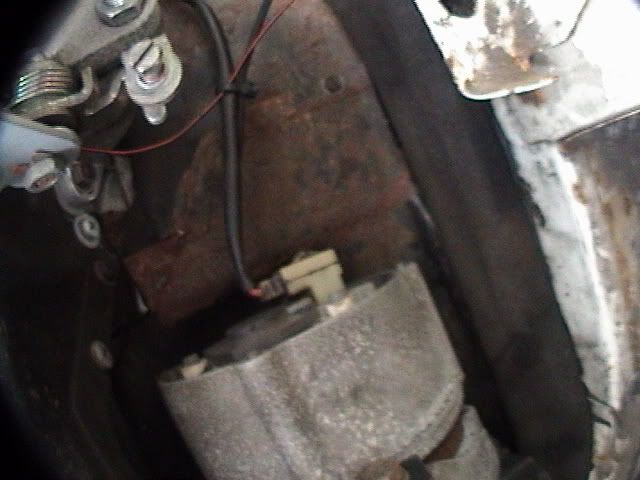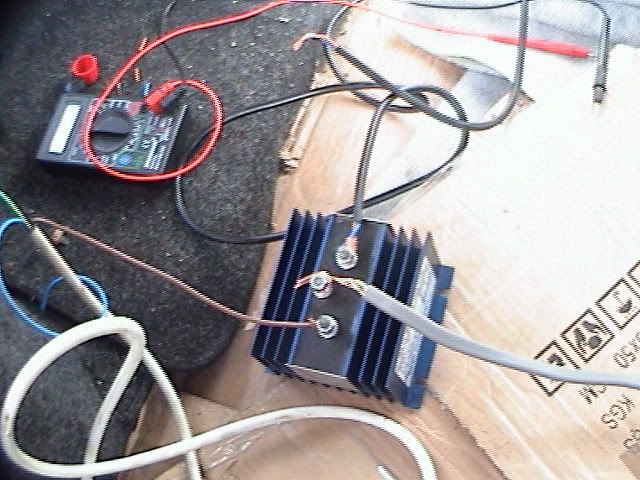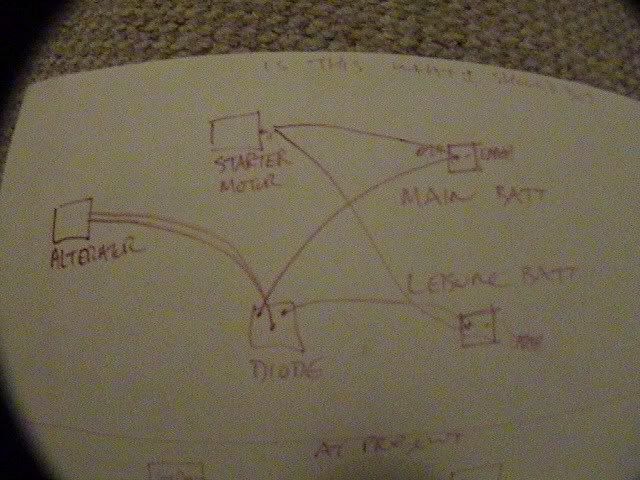Page 1 of 2
split charge diode - fitting advice
Posted: 05 Mar 2012, 14:16
by avant-garde
Hi, a little bit of advice needed please. I'm about to fit my split charge diode and before I start I just wanted to be clear in my head on a few things.

Going by this I have looked at the back of my alternator and there are two red wires going to the starter motor. Instead of disconnecting these two red wires coming out of the alternator can I simply add some thick gauge wire to the back of the starter motor onto the same stud that these two red wires are attached to?

A not very clear photo of where the two red wires from the alternator attach to the back of the starter motor.

The back of the alternator where the two red wires (which are in the same sleeve) come out of.

The split charge diode.
So I would run a thick 'kitchen oven/cooker' cable from the starter motor to the center stud on the diode. The two other studs on the diode go to each + battery terminal. Obviously I would tidy it all up etc.
Is this okay to do?

Split charge diode v's relays. Am I right in saying that the leisure battery and the main battery both receive charge at the same time when the engine is running or does the main battery have priority when charging? I'm not to clear on diodes/relays etc
On the side of the diode it says 'battery isolator', it was sold to me as a split charge diode. Is that the same thing?
Once again I appreciate any help that anyone can offer me.
Many thanks.
Re: split charge diode - fitting advice
Posted: 05 Mar 2012, 14:39
by CovKid
Yes on the red wire connection.
Re: split charge diode - fitting advice
Posted: 05 Mar 2012, 14:57
by avant-garde
Brilliant, thanks for that CovKid. Big thick cable from the back of the starter motor to the center stud on diode.

Next job is to repair my windscreen lip as I have the dreaded footwell leaks on both sides. I've read your wikki article CovKid and it's very inspiring.

Thanks again.
Re: split charge diode - fitting advice
Posted: 05 Mar 2012, 16:33
by Oldiebut goodie
I am wondering why you are using a diode in preference to a relay as you will suffer around a 0.9v voltage drop with the diode? Even the Sterling diodes suffer a 0.75v voltage drop. Do you have solar panel/s to top up the leisure battery?
Using cooker cable is inadvisable - you need to use multistranded cable to avoid work hardening due to vibrations.
Re: split charge diode - fitting advice
Posted: 05 Mar 2012, 16:56
by bigherb
Split diodes are a pain to to fit on T25's and not really suited to the older style charging systems, like Oldie says to much voltage drop, they work OK on T4's and T5's
You have to remove the alternator connection from the starter motor and connect it to the centre diode terminal then run two separate cables from the outer terminals to each battery. Don't use household cable in vehicles use the proper flexible cables.
Re: split charge diode - fitting advice
Posted: 05 Mar 2012, 18:09
by avant-garde
bigherb wrote:Split diodes are a pain to to fit on T25's and not really suited to the older style charging systems, like Oldie says to much voltage drop, they work OK on T4's and T5's
You have to remove the alternator connection from the starter motor and connect it to the centre diode terminal then run two separate cables from the outer terminals to each battery. Don't use household cable in vehicles use the proper flexible cables.
Why do I have to remove the alternator connection to the starter motor? Surely all I have to do is connect a thick cable to the back of the starter motor where the two red cables from the alternator are attached and run this new cable to the center stud on the diode.
I'm only using the diode to power my radio. When not on electric hook up also the fridge.

I've had 3 relays in the past and I've never managed to get them to work. That's the reason why I've gone for the simpler split diode wiring set-up.
Re: split charge diode - fitting advice
Posted: 05 Mar 2012, 18:22
by bigherb
Because the starter battery would still be connected to the alternator via the starter cable bypassing one of the diodes.
Re: split charge diode - fitting advice
Posted: 05 Mar 2012, 18:34
by BOXY
I'm only using the diode to power my radio. When not on electric hook up also the fridge.
I reckon your fridge would flatten a battery before the beer was chilled. If you're not on hook-up use gas.
Re: split charge diode - fitting advice
Posted: 05 Mar 2012, 18:51
by avant-garde
bigherb wrote:Because the starter battery would still be connected to the alternator via the starter cable bypassing one of the diodes.
...I don't understand why would that be a problem?

Is the rough sketch above what I should do then?
1.Both red cables from the alternator to the center stud on the diode.
2. The outer studs on the diode run one cable to one battery + terminal.
3. Each + terminal on both the main and leisure battery connect to the starter motor.
Thanks.

Re: split charge diode - fitting advice
Posted: 05 Mar 2012, 19:01
by avant-garde
BOXY wrote:I'm only using the diode to power my radio. When not on electric hook up also the fridge.
I reckon your fridge would flatten a battery before the beer was chilled. If you're not on hook-up use gas.

I don't understand. Why do people have split charge systems then?
My partner does not like the idea of using gas to power a fridge

she doesn't like the idea of explosions.
Sorry if I'm coming over as caustic.
Re: split charge diode - fitting advice
Posted: 05 Mar 2012, 19:14
by kevtherev
Have you considered the amperage to run a fridge?
If you are running it from a battery (when a perfectly safe gas option is available) then may I suggest you invest in a fridge that makes better use of your available power. The fridge better suited would be a compressor type.
Split charge systems allow the recharging of batteries, after a couple of nights camping, then a 1 hour drive, should see the battery back to a good level.
if you have a LOT of Amp hour capacity, then fridges can be run... but start turning the radio on and the lights... it will soon drain it
compressor fridges make better use of the battery power
Re: split charge diode - fitting advice
Posted: 05 Mar 2012, 19:23
by Oldiebut goodie
You have already posted the circuit - why are you trying to change it? Why are you considering a cable effectively between the starter battery and the leisure one? All you are doing is connecting the two batteries.
Re: split charge diode - fitting advice
Posted: 05 Mar 2012, 20:20
by avant-garde
Oldiebut goodie wrote:You have already posted the circuit - why are you trying to change it? Why are you considering a cable effectively between the starter battery and the leisure one? All you are doing is connecting the two batteries.
I'm not connecting the two batteries. Each + terminal from the two batteries would be connected to the rear of the starter motor. Not to each other.
Bigherb wrote: You have to remove the alternator connection from the starter motor and connect it to the centre diode terminal then run two separate cables from the outer terminals to each battery.
Whereas CovKid: wrote: Yes on the red wire connection. (to my question - can I simply add some thick gauge wire to the back of the starter motor onto the same stud that these two red wires are attached to?)
So basically two different answers.
The problem is that the alternator is attached to the starter motor...this is what I can't get my head around.

Re: split charge diode - fitting advice
Posted: 05 Mar 2012, 20:27
by kevtherev
avant-garde wrote:Oldiebut goodie wrote:You have already posted the circuit - why are you trying to change it? Why are you considering a cable effectively between the starter battery and the leisure one? All you are doing is connecting the two batteries.
I'm not connecting the two batteries.
Each + terminal from the two batteries would be connected to the rear of the starter motor. Not to each other.
effectively they are connected then
Re: split charge diode - fitting advice
Posted: 05 Mar 2012, 20:31
by CovKid
Read the note under your first post which explains it perfectly. Doing it that way is (as they suggest) the easiest way. And, as everyone else has said, get the right cable too.









